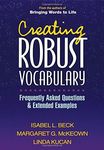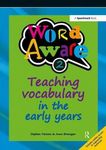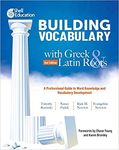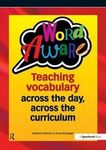USING READ-ALOUDS AS A FOUNDATION FOR ROBUST VOCABULARY INSTRUCTION - EMINA MCLEAN
←
→
Page content transcription
If your browser does not render page correctly, please read the page content below
Why have a specific focus on vocabulary? “A large and rich vocabulary is the hallmark of an educated individual. Indeed, a large vocabulary repertoire facilitates becoming an educated person to the extent that vocabulary knowledge is strongly related to reading proficiency in particular and school achievement in general.” (Beck, McKeown & Kucan, 2013, p. 1)
What we know about the importance of vocabulary knowledge (Graves, 2009) • It is closely related to reading comprehension (RC) across the grades and a predictor in the early years of RC in later years.* • Vocabulary instruction improves RC for English speakers and dual- or multi-language learners. Additionally, learning English vocabulary is one of the most important tasks for English language learners at school. • There are profound differences between the vocabularies of more advantaged and less advantaged students when they commence school and those gaps remain or widen during the school years if we do nothing about it. **
The goal of vocabulary instruction is to increase (in breadth and
depth) the number of words, feelings and ideas students can:
understand and demonstrate when talking and listening
understand, analyse and interpret when reading
use, describe and evoke when writingWhat is common practice? (Kindle, 2009) • Three levels of instruction (incidental, embedded or focused) • Incidental involved the teacher infusing a Tier 2 word into the discussion before, during or after the read-aloud with no direct teaching. • Embedded involved attention to word meaning with fewer than 4 teacher-student exchanges. • Focussed involved the teacher leading a discussion about word meaning but teacher-student exchanges varied in length (4-25).
What is common practice? (Kindle, 2009) • 9 instructional strategies were observed. • Questioning; providing a definition, providing a synonym; providing an example; clarifying or correcting a students’ response; extending a student generated definition; labelling; imagery; morphemic analysis “Read-alouds are instructional events and require the same advanced planning as any other lesson.” (Kindle, 2009, p.209)
A good question to ask Through my vocabulary instruction, am I facilitating comprehension in this moment only, or word learning for comprehension now and later?
Incidental and direct approaches There is a place for both (e.g. National Reading Panel, 2005) but: • A single contact with a word will rarely lead a student to understand and retain a word’s meaning (Nagy et al, 1987; Beck et al, 2013). Students need multiple exposures in multiple contexts in order to develop rich word knowledge. • Incidental → fast mapping (contextually appropriate but superficial knowledge; able to comprehend it now in context but probably not later) • Direct → fast then slow/extended mapping (deep knowledge; able to comprehend it now and later) Note, lower progress readers derive even less benefit from incidental approaches (e.g. Biemiller, 2001)
What is robust vocabulary instruction? “A robust approach to vocabulary involves directly explaining the meanings of words along with thought-provoking, playful, and interactive follow-up.” (Beck, McKeown & Kucan, 2013, p.3) • Select words and plan lessons ahead of time. • Make meanings explicit and clear using student friendly explanations. • Get students actively involved in thinking about and using the meanings in a variety of ways immediately. • Review and expand upon what has been taught a number of times in speaking, reading and writing tasks. Robust vocabulary instruction is effective for learning the meanings of words AND for improving reading comprehension.
Why Tier 2 words? The opportunity to learn Tier 2 words comes mainly from reading books. Students won’t just pick them up in everyday spoken language because we don’t use them very much.* Without Tier 2 words students can’t move from using everyday spoken language to becoming a literate language user. A barrier exists between everyday spoken and written (academic/book) language. Academic success is possible when students cross this so called ‘lexical bar’ (Corson, 1985;1995). Written meaning/context and the sophisticated vocabulary of written language is far harder to decipher than oral meaning/context due to: • the absence of verbal and nonverbal cues we use when speaking • the words are more abstract/less concrete/less imageable Students are therefore less likely to learn word meanings well just through reading them.
Why Tier 2 words? Tier 2 words are frequent in text. The most frequent 2000 words make up about 80% of what we read which leaves about 20% of words that are predominantly Tier 2 words (Nation, 2001; Beck, McKeown & Kucan, 2008). Knowledge of Tier 2 words is essential to reading comprehension and writing.
Should I explicitly teach Tier 1 words? No, Tier 1 words need virtually no attention (in RtI Tier 1) as the majority of students learn them independently.* Even though some students start school with smaller vocabularies than their peers for a variety of reasons, students who are behind will quickly build their Tier 1 vocabularies IF we provide linguistically rich classrooms. What will be of most use, given instructional time is precious, is to teach these students Tier 2 words along with their peers (the words less likely to be learned independently).
Why use read-alouds? We are (or should be) doing them anyway. We are capitalising on the opportunity. When done well, read-alouds improve vocabulary, comprehension, and narrative skills (Beck & McKeown, 2001; Santoro et al, 2008).
The steps • Step 1 – choose the read-aloud or text • Step 2 – choose the words to teach • Step 3 – develop student-friendly explanations and plan the lesson • Step 4 – deliver the lesson • Step 5 – retrieval practice • Step 6 – assessment/monitoring
Step 1: Choosing read-alouds or texts Early years • Not books they can read themselves • Rich literature and concepts • High interest for children • A link to the curriculum • Exposure to different cultures, ethnicities, settings, people, abilities and geographical locations • Text coherence (expository structure is clear) • Exposure to some words they would not come across in everyday spoken language • Exposure to language and ideas that takes them beyond the here and now/what’s known • A balance of text and illustration (engaging and rich text that conveys the story meaning with illustrations that confirm/reinforce text comprehension) • Informational and narrative texts Mid to late primary and secondary school • Exposure to a range of themes and ideas • Exposure to things you want them to know or think about • The full range of text types
Step 2: Choosing Tier 2 words Choose words: • with academic and social utility* or words that have mileage (they need to be useful) • that are not too easy, not too hard, just right (Goldilocks words as per Parsons & Branagan, 2017) • they likely won’t come across in everyday spoken language • that are more abstract (not concrete) with low(er) imageability • that are more complex and difficult to learn through incidental exposure How many words? Beck et al (2013) suggest ~2-3 per book* or ~10 words per week. If books in the early years don’t offer up good Tier 2 candidates, use the ideas expressed in the book or Tier 1 words to generate Tier 2 words to teach (Beck et al, 2013).
Step 3: Student friendly explanations
Prepare explanations for students following these key steps:
1. Look up the word in a few different dictionaries online. Hold in mind that
dictionary definitions are pretty useless as a way to learn new words.
2. Consider the definitions from the learner’s point of view, based on their
age/stage. We are trying to explain the word’s meaning rather than giving
them the definition. There is a difference.
3. Consider how you would characterise/frame the word so the meaning is
clear.
4. Consider everyday language that you can use to create the explanation.
5. Create the student friendly explanation ensuring the meaning is clear and
explicit. Scripts can be very useful here.Step 4: The lesson • Read the text. • Use initial questions (open questions that invite description or explanation about story ideas) and follow up questions (questions designed to scaffold students’ thinking and foster development and elaboration of ideas) throughout. • Students are active participants in teacher-led purposeful discussions about the story ideas afterward. • 1. Introduce the words and student friendly explanations. • 2. Solidify meaning straight away. • 3. Take the words beyond the story. • 4. Questions, reasons and examples • 5. Get them to make choices about the words. • 6. Get them to use all of the words.
Step 4.1: Introduce word meanings • There is no need to introduce the word beforehand if you are reading aloud together. * (i.e. no pre-teaching) • As an alternative to pre-teaching words that are disruptive to RC, you can provide a student-friendly explanation in the moment that the word is encountered when reading and move on. • Once the book has been read and purposeful text discussion has concluded, introduce each word and their student friendly explanations.
Step 4.2: Solidify meaning
Word associations
Once you have provided student friendly explanations, get students to associate the new words with words
or phrases you present. Get them to explain their reasoning.
Describe a time when you…
Get students to associate the word with a range of contexts from their own experience so they can see it
being of personal use.
Clapping
Get students to clap (taking turns) how much or how little they would like to be described by the target word
and then they need to justify their response.
Which would you rather? When/how/why might you?
Ask a range of questions about the target words.
This section requires some preparation as well e.g. synonyms, phrases, questions.
(Beck et al, 2013)Step 4.3: Take the words beyond the story
Provide extended examples of the word meanings in a range of contexts.
For example, if I had taught the word meaning for ‘dazzling’ and the context was that
in the story, Nathaniel had dazzling teeth, I would want to make sure I gave other
examples that weren’t about teeth or necessarily about vivid colours.
Sunlight
Diamond
Performance of an athlete or debating team member (non-literal)
Art on display
(Beck et al, 2013)Step 4.4: Questions, reasons and examples
“I am going to ask you some questions about the words we have learned. I want you to use
reasons or examples in your responses.”
For example:
Which of these three things is impressive? Tell me why or why not. [list three things]
What is something you could do to encourage your peer? Why? What are some of the reasons
why we might encourage our peers?
If you are holding a baby, you need to do it carefully. Why? What are some other things that you
need to do carefully?
(Beck et al, 2013)Step 4.5: Making choices
“I’m going to say some things. I want you to tell me if they are examples of the word we are
focusing on or not. If they are examples of the word, I want you to say that word. If they are not
examples, you don’t need to say anything.”
The word is jubilant. Say jubilant if any of the things I say would mean someone was jubilant.
Sitting on a chair
Winning the netball match
Washing the dishes
Becoming school captain
Winning Tattslotto
(Beck et al, 2013)Step 4.6: Using all the words
“We have learned three words today. Those words were ___ , ___ and ___. I
want us to think about them some more now before we finish the lesson.”
• Relating words (ask students to share ways in which the words are/could be
related using full sentences)
• Sentences (ask a question using more than one of the target words in the
question)
“Would you prefer to disturb a sleeping dog or ferocious wolf? Why?”
(Beck et al, 2013)Step 4.6: Using all the words
• Choices (ask a question using an example and get students to choose between two target
words in their answer)
“If you pack your bag the night before school, would that be sensible or complicated ?”
• Students create their own examples (ask a question to which they must respond with a
detailed explanation)
“If I told you I was feeling radiant, what might have happened?”
“Why might someone be walking cautiously ?”
(Beck et al, 2013)Step 5: Retrieval practice
GORDON (2020) EFFECTIVE FOR ALL OF PARTICULAR “DESIRABLE
STUDENTS BENEFIT TO DIFFICULTY”
STUDENTS WITH DLD
Review is essential to stimulating long-term learning/retention of vocabulary (Beck, Perfetti &
McKeown, 1982).
Review is often absent or insufficient (Beck & McKeown, 2005) which leads to students knowing
the word now but not later.An example teach and review model
Monday Tuesday Wednesday Thursday Friday
Teach 3 new words Practice/review Teach 3 new words Practice/review Review all
Week 1 Monday Wednesday
Review Week 3*
Teach 3 new words Practice/review Teach 3 new words Practice/review Review all
Monday Wednesday
Week 2 Review Week 1
Teach 3 new words Practice/review Teach 3 new words Practice/review Review all
Monday Wednesday
Week 3 Review Week 2Considerations for older students • More of a focus on reading and writing than in the early years • Different texts and longer texts • Tier 3 words for informational text comprehension and use • Texts are not read in a day so choose a number of words per day or per chapter. • If you are reading the book across the week, or across the fortnight, or across a month, create a teaching cycle around that. • Create a word wall each week so students can refer to the words throughout the week. • Get students to record word meanings as they are taught (e.g. vocabulary workbook).
A teach and review model for older students
Monday Tuesday Wednesday Thursday Friday
Read text (e.g. Follow up Follow up Follow up Assess word
Chapter 1-2) activities (e.g. activities (e.g. activities (e.g. knowledge
making choices, making choices, making choices,
Introduce words word associations, word associations, word associations,
questions, reasons questions, reasons questions, reasons *Revise words
Explain story & examples & examples & examples taught in the
context etcetera) etcetera) etcetera) previous week
Provide student Writing sentences Writing sentences Writing sentences
friendly
explanations Students record
word meaning in
Create the word their own
wall vocabulary
workbook
(Adapted from the 5 day cycle: Beck at al, 2013)Step 6: Assessment and monitoring • Benchmarking/criterion referenced/norm referenced/standardised assessments have their limitations. • McKeown et al (1985) compared definitional and robust approach to instruction, and found that on MCQ high numbers of encounters with words impacted results but the type of instruction did not. However, on comprehension tests, the type of instruction mattered, along with the number of encounters. • Assessment design therefore matters. We need to make sure we are assessing our impact on future RC, not just shallow assessment of their word knowledge e.g. capacity to choose a synonym. • How well we know words it not an all or nothing principle. The deeper the word-learning, the more likely it is to have an impact on RC. As above, our assessments/reviews need to reflect this.
Step 6: Assessment and monitoring
• Present similarly featured examples and non-examples of a word (students justify their
choices)
• Have students create examples of words taught (e.g. tell me about a time that you were
astonished ; describe an event that could make someone feel perplexed; describe
something that you find scrumptious and why it is scrumptious to you)
• Provide semantically similar word pairs (e.g. exotic and unique) and have students explain
what is similar and what is different about the two.
• Contextual interpretation questions:
e.g. When Nathaniel and I arrived at Emina’s door, I had to encourage Nathaniel to knock on
the door. How do you think Nathaniel felt about seeing Emina? Why?
e.g. Nathaniel told me he was a novice, but when I saw him teaching vocabulary I knew he had
been kidding. What do you think Nathaniel’s vocabulary instruction was like? Why?
• Sentence completion tasks (written).
• MCQ and true/false traditional formats can be okay but give them some thought.*
(Beck et al, 2013)Who may need additional instruction? About 90% of students are able to acquire new vocabulary at the rate required to remain at grade level with the right instruction (e.g. Biemiller, 2001). There are two groups of students who may struggle with word learning, and in turn, listening/talking and reading/writing: A DIFFERENCE IN WORD LEARNING OPPORTUNITY • students from linguistically disadvantaged backgrounds • students who are dual- or multi-language learners • students who miss a lot of school • students with sensory impairments A DIFFERENCE IN WORD LEARNING ABILITY • students with Language Disorder associated with another diagnosis • students with Developmental Language Disorder
Developmental Language Disorder • These students usually need to hear words twice as often before comprehending and then using the word independently (Paul, Norbury & Gosse, 2018). • They need additional, repeated, enriched, opportunities for practice in order to understand word meanings and their referents (Paul, Norbury & Gosse, 2018). • It is helpful to highlight semantic AND phonological features of words (Paul, Norbury & Gosse, 2018). • “…word‐learning difficulties experienced by children with SLI may originate at the fast mapping stage, and that phonological STM and receptive vocabulary significantly predict fast mapping ability” (Jackson et al, 2015, p.61). • “…children with DLD demonstrate an impaired capacity to encode phonological information…which impacts fast mapping” (Jackson et al, 2019, p.11)
Students with RC difficulties benefit even more from vocabulary instruction “…vocabulary training does increase comprehension for all students. In addition, students identified as having reading problems made more than three times the gains than students with no indicated reading problem. This pattern, however, was not the same with the vocabulary outcomes. Students with reading difficulties made equivalent gains in vocabulary knowledge as those without.” (Elleman et al, 2009, p.34).
In closing Read-alouds must be carefully planned if they are to affect vocabulary development and reading comprehension (Santoro et al, 2008). “A substantially greater teacher-centred effort is needed to promote vocabulary development, especially in the early years.” (Biemiller, 2001, p.26) Ensure “systematic exposure to two to three new words per day combined with adequate explanation of these words and opportunities to use them.” (Graves, 2009, p.34) “Engaging children in active analysis of word meanings is more effective at promoting their learning of new words than instruction that merely has children relate words to the context of a story and to personal experiences in a less analytical, more context-bound way.” (Silverman, 2007, p.107) “Instruction that succeeded in affecting comprehension included three features: more than several exposures to each word, both definitional and contextual information, and engagement of students in active, or deep, processing.” (Beck, McKeown & Kucan, 2008, p.4)
References/resources • Beck, I. L., McKeown, M. G., & Kucan, L. (2013). Bringing words to life: Robust vocabulary instruction. Guilford Press. • Beck, I. L., McKeown, M. G., & Kucan, L. (2008). Creating robust vocabulary: Frequently asked questions and extended examples (Vol. 10). Guilford Press. • Beck, I. L., & McKeown, M. G. (2001). Text talk: Capturing the benefits of read-aloud experiences for young children. The Reading Teacher, 55(1), 10-20. • Beck, I. L., Perfetti, C. A., & McKeown, M. G. (1982). Effects of long-term vocabulary instruction on lexical access and reading comprehension. Journal of Educational Psychology, 74(4), 506. • Biemiller, A. (2001). Teaching vocabulary: Early, direct, and sequential. American Educator, 25(1), 24-28. • Biemiller, A. (2010). Words worth teaching: Closing the vocabulary gap. Columbus, OH: McGraw-Hill SRA. • Corson, P. (1996). Using English words. Springer Science & Business Media. • Corson, D. (1985). The lexical bar. Pergamon Press. • Elleman, A. M., Lindo, E. J., Morphy, P., & Compton, D. L. (2009). The impact of vocabulary instruction on passage-level comprehension of school-age children: A meta-analysis. Journal of Research on Educational Effectiveness, 2(1), 1-44.
References/resources • Gordon, K. R. (2020). The advantages of retrieval-based and spaced practice: Implications for word learning in clinical and educational contexts. Language, Speech, and Hearing Services in Schools (2020),1-11. • Graves, M. F. (Ed.) (2009). Essential readings on vocabulary instruction. International Reading Association. • Hadley, E. B., & Mendez, K. Z. (2020). A systematic review of word selection in early childhood vocabulary instruction. Early Childhood Research Quarterly, 54(2021), 44-59. • Jackson, E., Leitao, S., Claessen, M., & Boyes, M. (2019). Fast mapping short and long words: Examining the influence of phonological short-term memory and receptive vocabulary in children with developmental language disorder. Journal of Communication Disorders, 79, 11-23. • Jackson, E., Leitao, S., & Claessen, M. (2016). The relationship between phonological short‐term memory, receptive vocabulary, and fast mapping in children with specific language impairment. International Journal of Language & Communication Disorders, 51(1), 61-73. • Joshi, R. (2005). Vocabulary: A critical component of comprehension. Reading & Writing Quarterly, 21(3), 209-219. • Kindle, K. J. (2009). Vocabulary development during read‐alouds: Primary practices. The Reading Teacher, 63(3), 202-211. • Marzano, R. J., & Pickering, D. J. (2005). Building academic vocabulary: Teacher's manual. Association for Supervision and Curriculum Development.
References/resources
• McKeown, M. G., Beck, I. L., Omanson, R. C., & Pople, M. T. (1985). Some effects of the nature
and frequency of vocabulary instruction on the knowledge and use of words. Reading
Research Quarterly, 522-535.
• Nagy, W. E., Anderson, R. C., & Herman, P. A. (1987). Learning word meanings from context
during normal reading. American Educational Research Journal, 24(2), 237-270.
• Nation, P. (2005). Teaching and learning vocabulary. In Handbook of research in second
language teaching and learning (pp. 605-620). Routledge.
• National Reading Panel (2005). Teaching children to read: An evidence based assessment of
the scientific research literature on reading and its implications for reading instruction.
Retrieved from
https://www.nichd.nih.gov/sites/default/files/publications/pubs/nrp/Documents/report.pdf
• Parsons, S., & Branagan, A. (2017). Word Aware: Teaching vocabulary across the day, across
the curriculum. Routledge.
• Parsons, S., & Branagan, A. (2017). Word Aware 2: Teaching Vocabulary in the Early Years .
Routledge.References/resources
• Paul, R. Norbury, C. F. & Gosse, C. (2012). Language disorders from infancy through
adolescence. St. Louis (MO): Elsevier Health Sciences.
• Raskinski, T., Padak, N., Newton, R. & Newton, E. (2020). Building vocabulary with Greek and
Latin roots: A professional guide to word knowledge and vocabulary development . Shell
Education.
• Santoro, L. E., Chard, D. J., Howard, L., & Baker, S. K. (2008). Making the very most of
classroom read‐alouds to promote comprehension and vocabulary. The Reading
Teacher, 61(5), 396-408.
• Silverman, R. (2007). A comparison of three methods of vocabulary instruction during read-
alouds in kindergarten. The Elementary School Journal, 108(2), 97-113.You can also read
























































